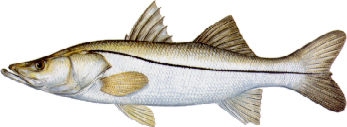| Common name: |
Snook, Centropomus undecimalis |
| Range: |
Four species of snook can be found in Florida waters. In Tampa Bay, the most abundant species is Centropomus undecimalis - the common snook. Unlike many premier game fish, snook are usually caught close to land in coastal and brackish waters, near or in mangrove stands, bridges or nearshore reefs and pilings. Snook is a cold-sensitive species and during winter months, they normally move into rivers, canals and streams that provide thermal refuge from the cooler waters of Tampa Bay and the gulf. Snook can tolerate either fresh or salt water in all life stages, however most juvenile snook utilize low-salinity or fresh water during a critical period in their development. |
| Anatomy: |
A characteristic large mouth and protruding lower jaw make snook easy to recognize. With extraordinarily strong bodies and prominent dorsal fins, snook are among the state's most sought-after game fish. They range in size from more than 44 pounds (the state record) to more common catches of five to eight pounds. |
| Diet: |
Adult snook feed primarily on fish and large crustaceans. Juvenile snook utilize low-salinity habitats with physical structures, such as mangroves or pilings, where they feed upon small crabs and mysid shrimp. After they reach about two inches in length, their diet changes to include shrimp and small fish. |
| Spawning: |
Snook spawn during the late spring and summer. Large schools of mature individuals congregate along the beaches near and in coastal passes during spawning season. |
| Catching Snook: |
Entire books have been written on catching this elusive fish with a fight that has been compared to tarpon twice its size. The most important "book," however, may be state regulations that define seasons, bag and size limits, and harvest limitations.
- Snook must be at least 26 inches long, but not more than 34 inches long.
- Only one fish per person can be harvested per day on the Gulf Coast.
- Snook cannot be harvested between Dec. 15 and Jan. 31, or from May to August on the Gulf Coast.
- A snook stamp is required to harvest snook when a saltwater fishing license is required.
- It is illegal to buy or sell snook.
- Regulations for snook caught in the Atlantic are slightly different. Check with the Florida Fish & Wildlife Conservation Commission.
|
Boys will be boys·
Not always! Many snook begin life as males then become female as they mature, a fairly common adaptation in fish. Recent research indicates that males reach maturity during their first year while they are only about six to eight inches long, which is smaller and younger than previously suspected. Mature males become mature females shortly after their first spawning. Most large snook are female. |
|





